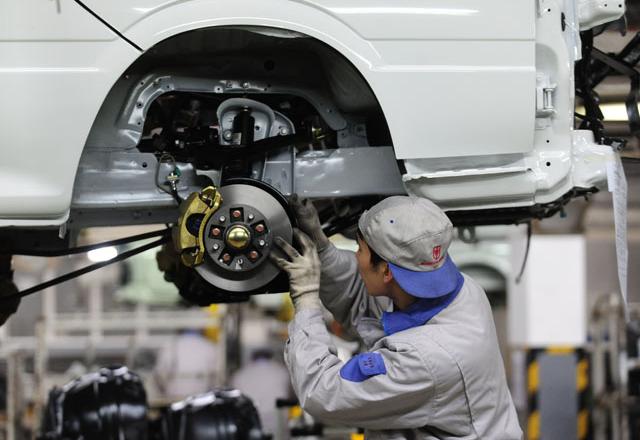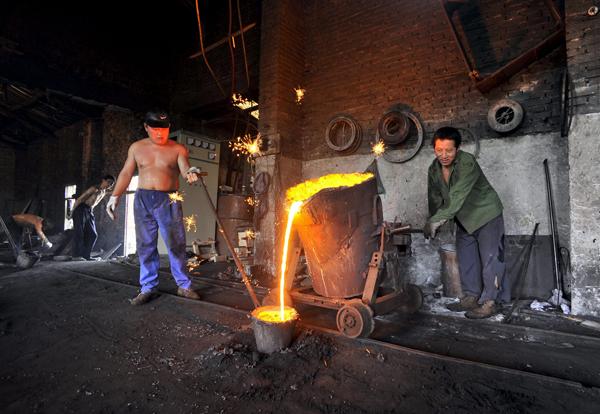You are here
China 2014 trade surplus rockets to record high
By AFP - Jan 13,2015 - Last updated at Jan 13,2015

BEIJING — China's trade surplus soared by almost half last year to a record $382 billion, the government announced Tuesday, but the world's second-largest economy again missed its trade growth target due to weakness overseas.
Exports increased 6.1 per cent to $2.34 trillion in 2014, while imports rose 0.4 per cent to $1.96 trillion, the General Administration of Customs indicated on its website.
That translated into a trade surplus of $382.46 billion, the highest ever and a 47.2 per cent increase on 2013.
China's huge trade surpluses were long a source of friction between Beijing and Washington, as the workshop of the world pumped out manufactured goods and US debt mounted, but the issue receded in more recent years.
Total trade in 2014 rose just 3.4 per cent from the year before, far below authorities' aim of about 7.5 per cent and the third consecutive year the official target has been missed.
"The world economy recovered rather slowly and couldn't support China's trade growing at a high speed," said Customs spokesman Zheng Yuesheng.
"China's comparative advantage of low costs continued to wane, while investment in China's manufacturing industry from developed economies declined, containing trade [growth]," he added, noting that foreign-invested companies are responsible for about half the country's exports.
Zheng attributed the record surplus to falling international commodity prices which dragged down import values.
The trade figures come as China's economy rounds out a disappointing 2014, with growth slowing because of manufacturing weakness, falling property prices and high corporate and local government debt burdens. This prompted the central People's Bank of China (PBoC) in November to cut benchmark interest rates for the first time in more than two years.
Gross domestic product (GDP) expanded an annual 7.3 per cent in the third quarter, the slowest since the height of the global financial crisis in early 2009.
Some economists expect figures showing further weakness at the end of last year and in the year ahead, with authorities openly describing slower and hopefully more sustainable expansion as a "new normal".
'Negative factors'
For December alone, the trade surplus soared 93.5 per cent year-on-year to $49.6 billion, as exports increased 9.7 per cent to $227.5 billion and imports fell 2.4 per cent to $177.9 billion, customs indicated.
It had initially given the figures in yuan terms, with different percentage changes as a result of exchange rate movements.
The export figure exceeded the median forecast of 6 per cent by 40 economists in a Bloomberg survey, while the fall in imports was less severe than their prediction of a 6.2 per cent decline.
Zheng remarked that while China's trade growth is likely to rebound this year, it faces headwinds.
"We think the negative factors containing trade growth in 2014 will continue for a certain period of time," he said.
Julian Evans-Pritchard, China economist at Capital Economics, said the outlook for overseas shipments should be brighter this year and import growth is likely to remain soft.
"Looking ahead, although the global economy remains fragile, we nonetheless expect growth in many of China's key export markets, such as the US, to stage a slight recovery this year, which should provide support to Chinese exports," he wrote in a note.
"Meanwhile, we think that domestic demand, particularly for commodities, is likely to remain subdued and that those anticipating a stimulus-driven pick-up in investment or a marked turnaround in the property sector will be disappointed," he said. "As such, import growth is likely to remain weak."
Analysts called for further policy loosening given weak domestic demand.
"With domestic demand growth still depressed, policy easing is still needed," economists of China International Capital Corporation said in a research note.
The record-high trade surplus could lead to volatility in the yuan, which depreciated by 3 per cent against the dollar last year, warned ANZ analysts Liu Li-Gang and Zhou Hao.
"This divergence has made Chinese corporates become increasingly concerned about their large US dollar debt exposure," they wrote in a report, noting that they could rush to buy dollars.
"This could lead [to] both currency overshooting and increased volatility in the [yuan] exchange rate going forward," the analysts said, suggesting that the PBoC would probably intervene in such a scenario to prevent large capital outflows.
Separately, China's auto sales exceeded 23 million vehicles last year, an industry group said Monday, but annual growth halved from 2013 as a weaker economy took its toll on the world's biggest car market.
Sales rose 6.9 per cent, or 1.51 million vehicles, to 23.49 million, the China Association of Automobile Manufacturers (CAAM) indicated.
That was short of an 8.3 per cent growth target given by CAAM in July, itself a cut from an earlier forecast of 10 per cent, Bloomberg News reported.
In 2013, sales surged 13.9 per cent to 21.98 million vehicles, helped by a recovery in Japanese brands that were earlier hurt by a political row between Beijing and Tokyo.
CAAM described 2014 sales as "stable" in a statement.
"Faced with a complex international environment and the arduous task of domestic reform, development and stability, the auto sector... achieved sound development," it said.
At least seven cities have slapped limits on vehicle numbers to cut congestion and pollution, including the southern boomtown of Shenzhen, which just announced a new policy to issue only 100,000 licence plates annually.
But China remained the world's biggest auto market last year, a title it has held since 2009, well ahead of the United States.
Industry consultant Autodata has estimated total US sales last year reached 16.5 million units, up 5.9 per cent from 2013.
Foreign brands shine
China's passenger car sales, which account for the bulk of the market, rose a stronger 9.9 per cent to 19.70 million vehicles in 2014, CAAM pointed out.
"The performance of the passenger car sector was within expectations and the slower overall growth is mainly due to a decline in sales of commercial vehicles," John Zeng, general manager of LMC Automotive Consulting in Shanghai, told AFP.
For 2015, passenger car sales were likely to maintain "relatively high" growth of 9 to 10 per cent, but an economic slowdown and stricter emissions regulations will hurt overall vehicle sales, Zeng said.
He forecast overall auto sales growth of 7.2 per cent for this year, nearly unchanged from 2014.
Foreign automakers in China outpaced the overall market, with Germany's Volkswagen (VW) as well as General Motors (GM) and Ford of the United States all reporting record sales for last year.
VW delivered 3.67 million cars to customers in China in 2014, up 12.4 per cent, the company said Sunday, despite recalling more than 500,000 of its vehicles.
GM sold 3.54 million vehicles in China, up 12 per cent from the previous high in 2013, it said last week.
"GM expects industry demand to rise once again this year in China," President of GM China Matt Tsien said in a statement.
Ford sold 1.11 million vehicles in China in 2014, up 19 per cent from 2013, according to the company.
According to CAAM, the market share of Chinese companies for passenger cars alone fell 2.1 percentage points in 2014, but gave no overall figure. Chinese firms held a 40.3 per cent market share for passenger vehicles in 2013, previous figures showed.
Related Articles
BEIJING — China's exports unexpectedly fell the most in two years in December, while imports also contracted, pointing to further weakness i
FRANKFURT — Germany, Europe's biggest economy, shaved 24 billion euros ($27 billion) off its overall public debt burden to 2.153 trillion eu
BEIJING — China's overcapacity in heavy industries is wreaking "far-reaching" damage on the global economy, with steel production "completel



















